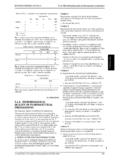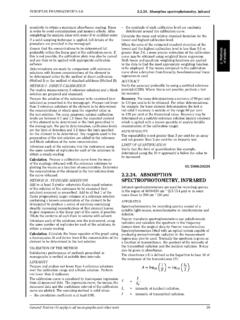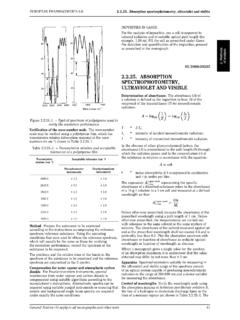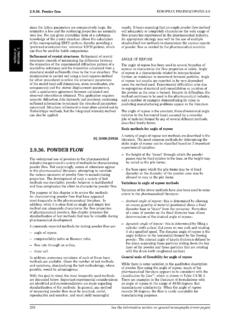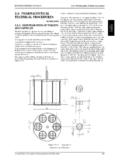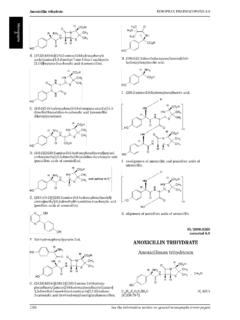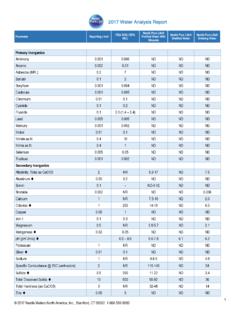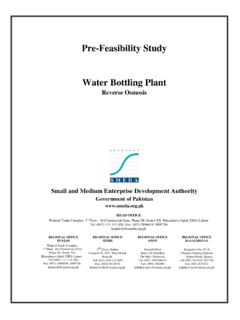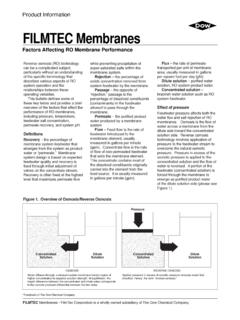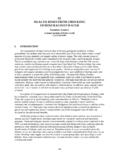Transcription of Conductivity Aqua purificata (°C) (µS·cm 1
1 EUROPEAN PHARMACOPOEIA , purifiedHeavy metals( ): maximum 200 ml in a glass evaporating dish on a water -bath untilthe volume is reduced to 20 ml. 12 ml of the concentratedsolution complies with limit test A. Prepare the standardusing 10 ml oflead standard solution (1 ppm Pb) endotoxins( ): less than label states, where applicable, that the substance issuitable for use in the manufacture of dialysis :0008correctedWATER, PURIFIEDAqua for the preparation of medicines other than thosethat are required to be both sterile and apyrogenic, unlessotherwise justified and water in bulkPRODUCTIONP urified water in bulk is prepared by distillation, by ionexchange, by reverse osmosis or by any other suitablemethod from water that complies with the regulations onwater intended for human consumption laid down by thecompetent production and subsequent storage, appropriatemeasures are taken to ensure that the total viable aerobiccount is adequately controlled and monitored.
2 Appropriatealert and action limits are set so as to detect adverse normal conditions, an appropriate action limit is atotal viable aerobic count ( ) of 100 micro-organismsper millilitre, determined by membrane filtration, using agarmedium S and incubating at 30-35 C for 5 days. The size ofthe sample is to be chosen in relation to the expected addition, the test for total organic carbon ( )witha limit of mg/l or alternatively the following test foroxidisable substances is carried out: to 100 ml add 10 mlofdilute sulphuric acid Rand ml M potassiumpermanganateand boil for 5 min; the solution remainsfaintly Determine the Conductivity off-line or in-lineunder the following cell: electrodes of a suitable material such as stainless steel; cell constant: within 2 per cent of the given valuedetermined using a certified reference solution with aconductivity less than 1500 S cm S cm 1on the lowest calibration ( Conductivity cell and conductometer): againstoneormoresuitablecertifiedstandar dsolutions.
3 Accuracy: within 3 per cent of the measured conductivityplus S cm calibration: by means of precision resistorsor equivalent devices, after disconnecting the conductivitycell, for all ranges used for Conductivity measurement andcell calibration (with an accuracy within per cent of thestated value, traceable to the official standard).If in-line Conductivity cells cannot be dismantled, systemcalibration may be performed against a calibratedconductivity cell placed close to the cell to be calibrated inthe water the Conductivity without temperaturecompensation, recording simultaneously the measurement may be performedafter suitable water to be examined meets the requirements if themeasured Conductivity at the recorded temperature is notgreater than the value in Table Temperature and conductivityrequirementsTemperature( C) Conductivity ( S cm 1)
4 Temperatures not listed in Table , calculate themaximal permitted Conductivity by interpolation betweenthe next lower and next higher data points in the water in bulk is stored and distributed in conditionsdesigned to prevent growth of micro-organisms and to avoidany other : clear and colourless 5 ml in a test-tube immersed in iced water , add mlof a 100 g/l solution ofpotassium chloride R, solution Rand, dropwise with shaking,5mlofnitrogen-free sulphuric acid a water -bath at 50 C. After 15 min, any blue colour inthe solution is not more intense than that in a referencesolution prepared at the same time in the same mannerusing a mixture of ml ofnitrate-free water Rand mlofnitrate standard solution (2 ppm NO3) ( ): maximum 10 ppb, if intended for use inthe manufacture of dialysis solution.
5 To 400 ml of the water to be examinedadd 10 ml ofacetate buffer solution pH Rand 100 ml ofdistilled water standardsolution (2 ppm Al) R,10mlofacetate buffer solutionpH Rand 98 ml ofdistilled water buffer solutionpH Rand 100 ml ofdistilled water (1)applytoallmonographsandothertexts2697 Wheat starchEUROPEAN PHARMACOPOEIA metals( ): maximum 200 ml in a glass evaporating dish on a water -bath untilthe volume is reduced to 20 ml. 12 ml of the concentratedsolution complies with limit test A. Prepare the standardusing 10 ml oflead standard solution (1 ppm Pb) endotoxins( ): less than IU/ml, ifintended for use in the manufacture of dialysis solutionswithout a further appropriate procedure for removal ofbacterial label states, where applicable, that the substance issuitable for use in the manufacture of dialysis water in containersDEFINITIONP urified water in bulk that has been filled and stored inconditions designed to assure the required microbiologicalquality.
6 It is free from any added : clear and colourless complies with the tests prescribed in the section onPurified water in bulk and with the following additional or alkalinity. To 10 ml, freshly boiled and cooled in aborosilicate glass flask, add ml ofmethyl red solution solution is not coloured 10 ml add ml ofbromothymol blue solution is not coloured acid Rand ml M potassiumpermanganateand boil for 5 min. The solution remainsfaintly nitric acid ml ofsilver nitrate solution R2. The solution shows nochange in appearance for at least 15 hydrochloric acid Rand ml ofbarium chloride solution no change in appearance for at least 1 : maximum 20 ml add 1 ml ofalkaline potassium tetraiodomercuratesolution ,examinethesolutiondownthevertical axis of the tube.
7 The solution is not more intenselycoloured than a standard prepared at the same time byadding 1 ml ofalkaline potassium tetraiodomercuratesolution Rto a mixture of 4 ml ofammonium standardsolution (1 ppm NH4)Rand 16 ml ofammonium-freewater and magnesium. To 100 ml add 2 ml ofammoniumchloride buffer solution pH R,50mgofmordantblack 11 triturate Rand ml M sodium blue colour is on evaporation: maximum per 100 ml on a water -bath and dry in an oven at100-105 C. The residue weighs a maximum of 1 contamination. Total viable aerobic count ( )not more than 102micro-organisms per millilitre, determinedby membrane filtration, using agar medium label states, where applicable, that the substance issuitable for use in the manufacture of dialysis :0359 WHEAT STARCHT ritici amylumDEFINITIONW heatstarchisobtainedfromthecaryopsisofTr iticumaestivumL.
8 (T. vulgareVill.).CHARACTERSA ppearance: very fine, white powder which creaks whenpressed between the : practically insoluble in cold water and in starch does not contain starch grains of any otherorigin. It may contain a minute quantity, if any, of tissuefragments of the original Examined under a microscope using equal volumesofglycerol Randwater R,itpresentslargeandsmallgranules, and, very rarely, intermediate sizes. The largegranules, 10 m to 60 m in diameter, are discoid or,more rarely, reniform when seen face-on. The centralhilum and striations are invisible or barely visible and thegranules sometimes show cracks on the edges. Seen inprofile, the granules are elliptical and fusiform and thehilum appears as a slit along the main axis. The smallgranules, rounded or polyhedral, are 2 m to 10 m indiameter.
9 Between crossed nicol prisms, the granulesshow a distinct black cross intersecting at the Suspend 1 g in 50 ml ofwater R, boil for 1 min and thin, cloudy mucilage is To 1 ml of the mucilage obtained in identification test B,add ml ofiodine solution R1. A dark blue colour isproduced which disappears on ( ): to g with ml ofcarbon dioxide-free water Rfor60 s. Allow to stand for 15 matter. Examined under a microscope using amixture of equal volumes ofglycerol Randwater R,notmore than traces of matter other than starch granules arepresent. No starch grains of any other origin are protein: maximum per cent of total protein(corresponding to per cent N2, ), determined on g by sulphuric acid digestion ( )modified as follows: wash any adhering particles from theneck into the flask with 25 ml ofsulphuric acid R;continuethe heating until a clear solution is obtained; add 45 ml ofstrong sodium hydroxide solution substances( ): maximum 20 ppm, calculatedas dioxide( ): maximum 50 ( ): maximum 10 g with 15 ml ofdilute hydrochloric acid filtrate complies with the limit test for on drying( ): maximum per cent, determinedon g by drying in an oven at 130 C for 90 ash( ): maximum per cent, determinedon the information section on general monographs (cover pages)
